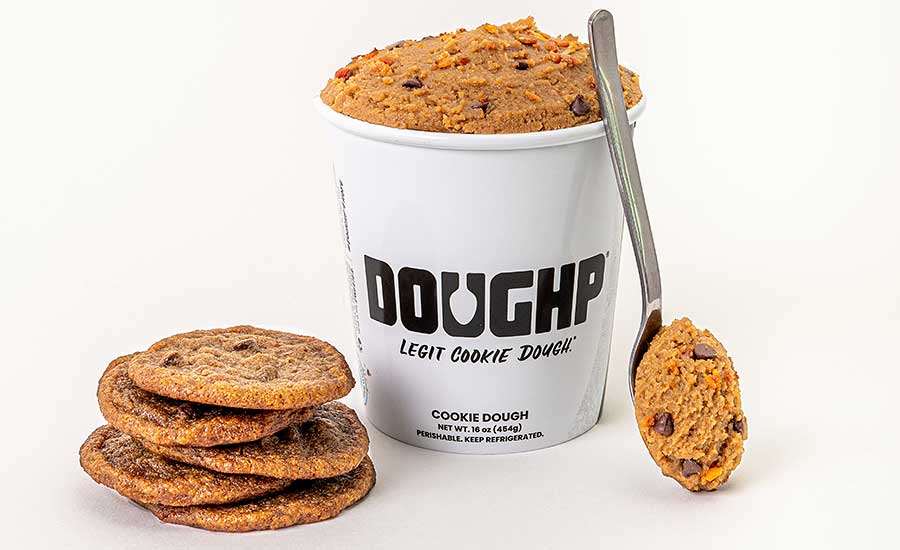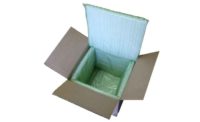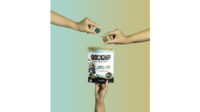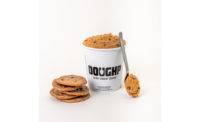Fans of Shark Tank may recognize Kelsey Moreira from her 2019 appearance on the show to gain backing for her edible cookie dough company, Doughp. Even though she didn’t get a deal, Doughp is doing just fine without it. The brand’s direct-to-consumer (DTC) model, combined with a strong social media presence and community outreach programs, has been a hit with consumers, while the company continues to add new flavors with quirky names like the French-inspired “Holy Crepe!”, or Dutch stroopwafel-themed “Stroop to my Level”.
Moreira founded Doughp in 2017, and initially opened a kiosk on Market Street in San Francisco, later moving to a scoop shop at PIER 39 in 2018. In 2019, Doughp opened a second location inside Planet Hollywood in Las Vegas. The San Francisco store closed in 2019 due to rising business costs in the city, according to Moreira. When the pandemic brought foodservice to a halt in 2020, the Vegas location was shuttered, and Doughp pivoted to an online-only, direct-to-consumer business model. Online sales took off quickly, driven in large part by the public’s rapid acceptance of e-commerce, and high demand for comfort food.
The company went from shipping about 30 orders a month before COVID-19, to 3,000 boxes per week afterward. Online sales skyrocketed from $50,000 in 2019 (out of $1.2 million in revenue), to $2.5 million in 2020, out of $2.7 million in revenue.
That momentum has continued into 2021—the company is on track for $5 million in online sales out of a projected $6 million in revenue. As Doughp continues to rise, we asked Moreira to share a few tips from her highly successful DTC strategy, and detail how e-commerce can either help or hinder the bottom line.

Some of Doughp's bestsellers include (clockwise from top) The colorful cookies and cream-flavored Cookie Monsta; traditional chocolate chip Ride or Die; the s'mores-themed You Want S'More?; and the rainbow sprinkle-infused Fairy Dust.
Moreira: After starting the company with a focus on in-person experiences in our owned brick-and-mortar scoop shops, we set our sights on e-commerce given the potential for scale and the immediacy with which we could dive in and grow it. Traditional grocery retail has a longer lead time, requires connections and brokers, and we wanted to move fast. So in late 2019 we set our sights on e-commerce and got off to the races!
R&FF: What advantages do you have from a production cost and product availability standpoint to deliver your products via DTC instead of retail distribution?
Moreira: Our margin is able to remain higher running DTC than it will be as we grow into retail. There are no slotting fees for DTC or required promotions that might not pay off, so if you’re able to efficiently acquire new customers, and have systems in place to help retain them and grow their lifetime value, you’ll keep a larger chunk of that cash at the end of the day. From a production standpoint, we’re aiming for consistency of presentation, inventory control, and quality assurance overall. Having our co-packing and fulfillment teams focused on the product from mixing to packing to boxing and shipping helps us ensure we know what the end customer will wind up receiving, every time.
In retail, the final point of purchase in some cases is left to the retailer on where they’ll place you, if your unit is facing forward so customers can see it, and other variables. With DTC we can own that unboxing experience and really send home the brand message more clearly with other added marketing materials and information as well.
R&FF: Retail distribution can double as marketing for some brands, based on shelf visibility for shoppers. What channels does Doughp use to stay on consumer radars and to update your customers about new products and promotions in order to grow your customer base?
Moreira: Since starting the company we have focused heavily on brand awareness, primarily through our presence through social media, growing our Instagram following to more than 70,000 and a new presence on TikTok with more than 40,000 followers. We also rely on email and SMS marketing. Our email list has grown to more than 85,000 cookie dough loving fans who enjoy a mix of mental health focused content for #Doughp4Hope with a healthy dose of recipes and new product drops.

"With DTC, we can own that unboxing experience and really send home the brand message more clearly," says Kelsey Moreira, founder & CEO of Doughp.

Doughp's Beast Mode brownie and chocolate chip flavor contains upcycled grains left over from beer brewing through a partnership with ReGrained, adding extra protein and fiber to the product.
R&FF: Delivering cold foods is far more difficult than delivering shelf-stable items because you’re at the mercy of the weather and other elements. What steps have you taken with your packaging and speed-of-delivery to ensure your products arrive cold on customer doorsteps?
Moreira: One of the most important decisions we made was to stand by a 100% Happiness Guarantee. No matter what you do, something can inevitably go wrong. We’re grateful that it doesn’t happen often, but when a shipment is late and melts we’re quick to get a new order out the door to the customer and do whatever we can to make it right. We made sure to educate ourselves in the matter—learning about insulation, coolants, and overall temperature control in transit was a big step, and depends on information that is scattered and incomplete online. Not many companies out there know how to do this right, and the ones that do keep that information secret since it’s such a competitive advantage. We also tested our packaging in several different scenarios with different insulation products and coolants to find the best solution for us. Most carriers have services to support brands that need to test temperature in transit with their packaging solution. In our case, FedEx was helpful along with our suppliers.
R&FF: How do you balance costs since overnight shipping is expensive, and many sustainable packaging materials can be more costly than traditional materials, like Styrofoam?
Moreira: My co-CEO lives and breathes this world. You have to find the sweet spot in cost efficiency between using too little insulation and spoiling your product, versus using too much and eating up your margins. There’s a lot of testing and math involved in finding what works best for your use case.
R&FF: How many cold storage distribution facilities do you use to ship your products, and are you eyeing additional distribution centers as a way to increase the speed of delivery to some regions?
Moreira: We used to have multiple distribution points trying to speed up delivery, but we found it is way more important to ensure product integrity and shipping quality than bi-coastal distribution. Today, we’re at just one fulfillment center. Our manufacturing and fulfillment are located in the same city, which is a huge benefit versus freight costs of a distributed network and this model works well with our shipping rate situation across the country.

Doughp cookie dough contains heat-treated flour, so it can be eaten raw straight from the pint, or baked into cookies.
R&FF: What is the next step in the evolution of your distribution model? Is grocery retail an option, or do you want to stay entirely DTC?
Moreira: We are super excited about the opportunity to get in front of more customers through retail, so we’ll be launching in select retailers this fall. It’s been four years of brand building to help make Doughp a recognizable brand. We can’t wait to put ourselves out there on shelves and increase the opportunity for people to discover our brand. I see retail as complementary to our DTC business since people who discover us in-store, will join us on social media or check out our website and find the great options for gifting, limited-edition flavor releases, and more reasons to connect directly with us down the line.
R&FF: What advice would you have for an aspiring startup cold foods company that wants to be 100% DTC and e-commerce focused? What are the initial pitfalls to watch at the beginning?
Moreira: Unit economics is the most important analysis a brand can do in the beginning. Making sure you’re making money in one single unit sold through your website after all cost of goods sold, operating expenses, and selling expenses are accounted for is the MOST important thing. Founders usually get caught up in cash in/cash out analysis and large invoices and POs and lose sight of what actually matters. The same goes for advertising. Keep the LTV/CAC ratio (customer lifetime value/customer acquisition cost) in your head and be sure their lifetime value is three to four times (3:1 to 4:1) the cost you paid to acquire them with ads.




